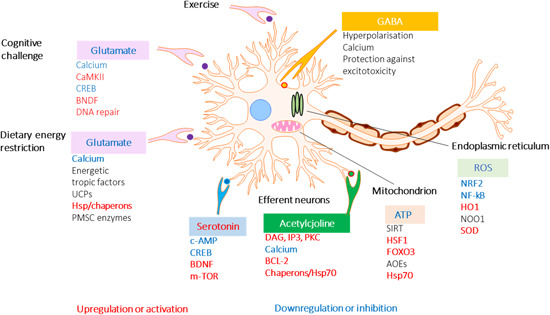Figure 3.

Effects of adaptogens on adaptive stress response signaling pathways that promote synaptic plasticity and protect neurons against degeneration. Illustration of a glutamatergic neuron receiving excitatory signals from neurons activated in response to intellectual tasks, exercise, and dietary energy restriction. Postsynaptic receptors for glutamate, acetylcholine, and serotonin, are activated to trigger intracellular signaling pathways and transcription factors that activate the expression of neuroprotective proteins including antiapoptotic proteins, brain‐mitochondrial uncoupling proteins (UCPs), and derived neurotrophic factor (BDNF). BDNF activates neuronal growth by stimulating the mammalian target of rapamycin (mTOR). Mild cellular stress resulting from dietary energy restriction and oxidative stress (ROS) activates adaptive stress response pathways including those that upregulate antioxidant enzymes (AOEs) and protein chaperones. CREB, cyclic AMP response element‐binding protein; CaMKII, calcium/calmodulin kinase II; DAG, diacylglycerol; FOXO3, forkhead box protein O3; HO1, heme oxygenase 1; HSF1, heat shock factor 1; IP3 PKC, inositol trisphosphate 3 protein kinase C; NF‐B, nuclear factor B; NRF2, nuclear regulatory factor 2 NQO1, NAD(P)H‐quinone oxidoreductase 1 (updated and adapted from Reference [59] and from authors’ drawings 16 [Color figure can be viewed at wileyonlinelibrary.com]
